ARCHIVED - Canadian Nuclear Safety Commission - Report
 This page has been archived.
This page has been archived.
Archived Content
Information identified as archived on the Web is for reference, research or recordkeeping purposes. It has not been altered or updated after the date of archiving. Web pages that are archived on the Web are not subject to the Government of Canada Web Standards. As per the Communications Policy of the Government of Canada, you can request alternate formats on the "Contact Us" page.
2012-13
Report on Plans and Priorities
Canadian Nuclear Safety Commission
The original version was signed by
The Honourable Joe Oliver, P.C., M.P.
Minister of Natural Resources
Table of Contents
Section I: Organizational Overview
- Raison d’être
- Responsibilities
- Vision
- Mission
- Mandate
- Strategic outcome and program activity architecture
- Organizational priorities
- Risk analysis
- Planning summary
- Expenditure profile
- Estimates by vote
Section II: Analysis of Program Activities by Strategic Outcome
- Strategic outcome
- Program Activity: Regulatory Framework
- Program Activity: Licensing and Certification
- Program activity: Compliance
- Program activity: Internal Services
Section III: Supplementary Information
Section IV: Other items of interest
President’s Message

As President of the Canadian Nuclear Safety Commission (CNSC), I am pleased to present the 2012–13 Report on Plans and Priorities.
Through legislation provided by Parliament, the CNSC is entrusted with an important mission: regulating nuclear facilities and activities to protect the health, safety and security of Canadians and the environment, and implementing Canada’s international commitments on the peaceful use of nuclear energy.
Above all else, the CNSC works every day to ensure the safe use of nuclear energy and materials in Canada. In the coming fiscal year, the CNSC will focus its efforts on some important priorities in the nuclear sector.
We will implement lessons learned documented in the Action Plan relating to the Fukushima Task Force Recommendations, in response to the devastating earthquake and tsunami that caused the Fukushima nuclear accident in Japan on March 11, 2011. Lessons learned from this event, resulting from careful reviews of safety at nuclear facilities in Canada and around the world, will be heeded by the industry and monitored by the CNSC, to ensure we remain vigilant about the safety of nuclear activities in this country. Internationally, the response to Fukushima will be a top priority for the International Nuclear Regulators Association which the CNSC chairs in 2012.
Our organization will also continue to play an important role in providing regulatory support to some important new major nuclear projects in Canada, one being Ontario Power Generation’s (OPG) proposed Deep Geologic Repository. OPG is proposing to construct and operate this facility at the Bruce nuclear site for the long-term management of low- and intermediate-level radioactive waste. A Joint Review Panel will be reviewing this proposal and report to the Federal government on its findings. This initiative and other projects before the CNSC are important to Canada’s energy strategy and to the economy.
The CNSC will continue to provide timely regulatory oversight of the OPG proposal for a new nuclear power plant, the refurbishment of existing reactors at Darlington, Point Lepreau and Gentilly-2, the latter pending a provincial decision, as well as the projects ongoing in Port Hope and Port Granby. Uranium mining projects include those ongoing and proposed new ones in northern Saskatchewan (e.g. Cigar Lake, Midwest and Millennium), the Matoush project in northern Quebec and proposed new mines in Canada’s far north (e.g., Kiggavik).
The Government of Canada is committed to regulatory reform initiatives to speed up regulatory approvals of major energy projects and to reduce the unnecessary burden on business while protecting the environment and health and safety of Canadians. In response, the CNSC is committed to supporting these efforts, as well as improving regulatory guidance to licensees. The CNSC will implement an online system for timelier and simpler compliance reporting by smaller licensees as part of its contribution to the Government’s Red Tape Reduction initiative.
We have set a vision to be the best nuclear regulator in the world. To realize this goal, the CNSC will continue to align its priorities under the “Core + Four Cs” framework –core regulatory work of licensing and compliance of over 2,500 licensees, commitment to ongoing improvement, clarity of our requirements, capacity for action, and communication.
We are able to fulfill our mandate because of the work of dedicated and skilled employees – located at each of Canada’s five power reactor sites, at Chalk River Laboratories, at four regional offices across the country and at our Ottawa headquarters. It is through the hard work and dedication of our people that we are able to regulate and ensure the safety of a diverse nuclear industry in Canada.
The CNSC will continue striving to realize its vision of being the best nuclear regulator in the world. Canadians can be assured that the CNSC is overseeing Canada’s nuclear sector so that safety is always our top priority.
____________________________
Michael Binder
President
Section I: Organizational Overview
Raison d’être
In 1946, the Canadian Parliament passed the Atomic Energy Control Act and established the Atomic Energy Control Board, providing it with the power to regulate all nuclear activities related to the development and use of atomic energy in Canada.
More than half a century later, in May 2000, the Nuclear Safety and Control Act (NSCA) came into effect and established the Canadian Nuclear Safety Commission (CNSC) as the successor to the Atomic Energy Control Board, with responsibilities and authorities to regulate an industry that spans all segments of the nuclear fuel cycle and a wide range of industrial, medical and academic uses of nuclear substances.
Responsibilities
The CNSC is an independent regulatory agency and quasi-judicial administrative tribunal, and has jurisdiction over all nuclear-related activities and substances in Canada.
Vision
To be the best nuclear regulator in the world.
Mission
Regulating nuclear activities to protect the health, safety and security of Canadians and the environment, and to implement Canada’s international commitments on the peaceful use of nuclear energy.
Mandate
Under the NSCA, the CNSC achieves its mission by:
- regulating the development, production and use of nuclear energy and substances, as well as the possession, use and transportation of nuclear substances
- implementing measures to meet international and domestic controls on the non-proliferation of nuclear weapons and nuclear explosive devices
- providing objective scientific, technical and regulatory information about the activities of the CNSC
In this context, the CNSC:
- is also responsible for implementing the Government of Canada’s December 2007 Directive to the Canadian Nuclear Safety Commission Regarding the Health of Canadians, which requires the CNSC – when regulating the production, possession and use of nuclear substances – to consider the health of those Canadians who, for medical purposes, depend on nuclear substances produced by nuclear reactors
- as a responsible authority under the Canadian Environmental Assessment Act, carries out environmental assessments for nuclear projects in accordance with this legislation
- designates installations under the Nuclear Liability Act
- is Canada’s authority with respect to the implementation of nuclear safeguards as set out in the Agreement Between the Government of Canada and the International Atomic Energy Agency for the Application of Safeguards in Connection with the Treaty on the Non-Proliferation of Nuclear Weapons
- administers the nuclear non-proliferation provisions of bilateral nuclear cooperation agreements that the Government of Canada enters into with foreign nuclear trade partners
The Commission has up to seven permanent members, appointed by the Governor in Council, and is supported by employees across Canada. The CNSC President is a permanent full-time Commission member, while other members may be appointed to serve on a full- or part-time basis. Temporary members can also be appointed by the Governor in Council, as required. Commission members are chosen according to their credentials, and are independent of any political, governmental, special interest group or industry influences.
As a quasi-judicial administrative tribunal and court of record, the Commission makes independent, fair and transparent decisions on the licensing of nuclear-related activities, establishes legally binding regulations, and sets regulatory policy direction on matters related to health, safety, nuclear security and the environment. For licensing matters related to major nuclear facilities, the Commission considers applicant proposals, recommendations of CNSC staff, and stakeholder views before making decisions. To promote openness and transparency, the Commission conducts its business to the greatest extent possible in public hearings and meetings and, where appropriate, in communities affected by the decision at hand. Commission hearings are conducted in a public forum approximately 10 times per year, and decisions are usually released within 30 business days after the closing of the hearings.
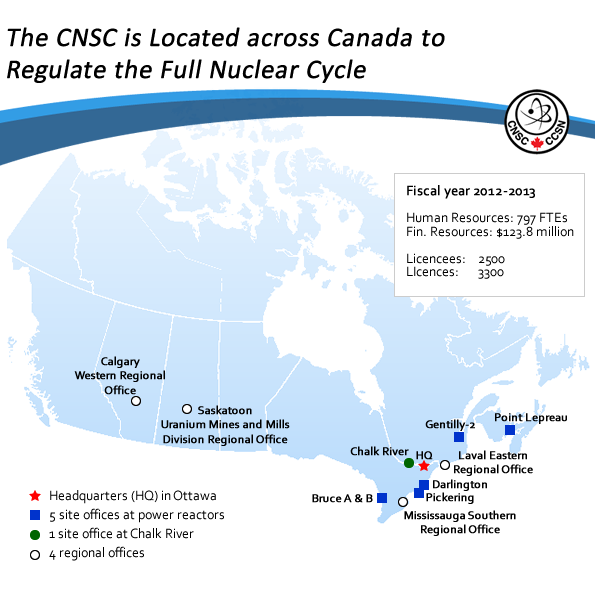
The following organizational chart1 provides additional details about the CNSC:
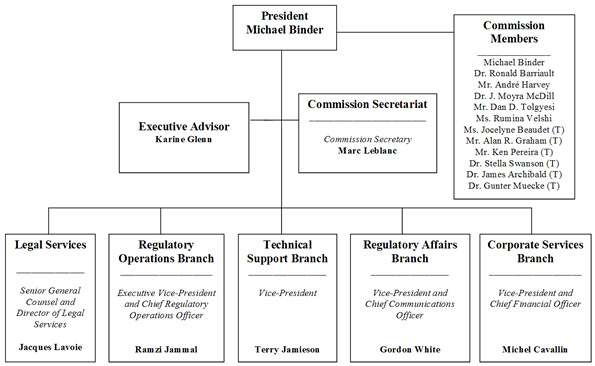
1 The (T) denotes temporary.
Strategic outcome and program activity architecture
The following diagram illustrates the CNSC’s strategic outcome, complete framework of program activities and program sub-activities, which support the strategic outcome:
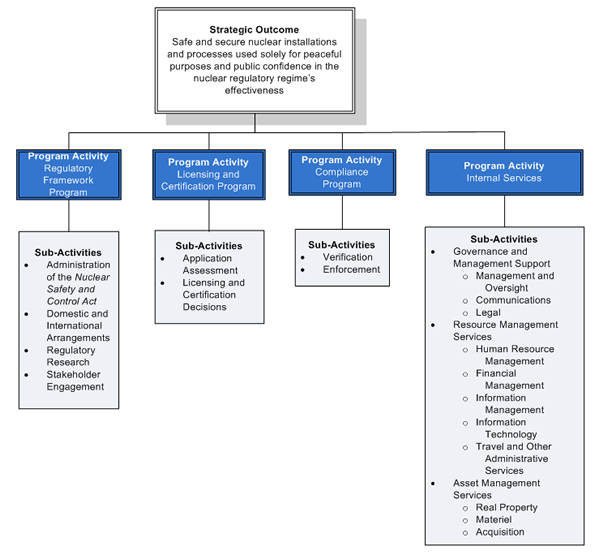
Organizational priorities
The CNSC’s “Core + Four Cs” is an overall framework to guide our work; it is our way of doing business.
- Core – “The CNSC is flexible, agile and ready for whatever may come our way.”
- Commitment to ongoing improvement – “Being the best in all that we do.”
- Clarity of our requirements – “Everyone understands what needs to be done.”
- Capacity for action –“Right people are in the right positions at the right times.”
- Communication – “Accurate, clear, concise and timely”
Core: The work that we do every day to ensure Canadian nuclear facilities and activities are safe. These activities fall under our Regulatory Framework, Licensing and Certification, Compliance and Internal Services program activities. By adhering to our Four Cs, we ensure that we are prepared to respond, regardless of the situation. In everything that we do, we will never compromise safety.
Commitment to ongoing improvement: Opportunities identified through audits, evaluations and lessons learned from operating experience. Specific improvement projects are managed under our Harmonized Plan for Improvement Initiatives, wherein clear deliverables are identified and accountability is assigned to ensure that all commitments are met.
Clarity: Creating broad and complete awareness among licensees and proponents of nuclear facilities and activities of the CNSC’s requirements stemming from the NSCA. Clarity also includes revitalizing the CNSC’s regulatory framework and clarifying requirements through the development of guidance documents.
Capacity for action: Ensuring that the CNSC’s internal capacity (people, IM/IT tools, infrastructure, etc.) is ready and able to respond to changing events.
Communication: Our efforts to be a transparent regulator. The CNSC seeks to communicate with stakeholders in an accurate, clear, concise and timely fashion and facilitate the exchange and dissemination of information. The objective is to strengthen communications with the CNSC’s licensees, stakeholders, Aboriginal peoples, international counterparts, and other government departments and central agencies, in accordance with our mandate to disseminate objective scientific, technical and regulatory information to the public concerning our regulatory activities.
Under our “Core + Four Cs” framework, the CNSC focuses its efforts on the following organizational priorities:
- Ensuring, above all else, the safe use of the nuclear energy and materials in Canada
- Implementing the CNSC Staff Action Plan on the CNSC Fukushima Task Force Recommendations
- Providing regulatory support to the Joint Review Panel (JRP) review of Ontario Power Generation’s proposed Deep Geologic Repository (DGR) for low- and intermediate-level nuclear waste
- Responding to the Government of Canada’s regulatory reform (Major Projects Management Office (MPMO), Red Tape Reduction Commission (RTRC))
- Preparing for the Darlington nuclear power plant refurbishment
- Preparing for the licence to construct new power reactor units at Darlington
The following tables provide additional details on our top organizational priorities.
| Priority | Type | Program Activity |
|---|---|---|
| 1. Ensuring, above all else, the safe use of nuclear energy and materials in Canada | Ongoing | All |
| Description | ||
|
Why is this a priority? As Canada’s nuclear regulator, the CNSC oversees Canada’s nuclear sector, ensuring its facilities and activities are among the safest and most secure in the world. The CNSC’s licensing and certification requirements, along with a compliance verification and enforcement regime, promote and assure the safe, secure operation of Canadian nuclear facilities and activities while protecting the health of Canadians and their environment. Plans for meeting the priority To meet this priority, the CNSC will carefully review licence applications to ensure that potential licensees meet all regulatory requirements before a licence is issued, and will provide stringent oversight of licensees’ operations to assure ongoing compliance. The CNSC will not license a facility unless it is clearly satisfied that it is safe. |
||
| Priority | Type | Program Activity |
|---|---|---|
| 2. Implementing the CNSC Staff Action Plan on the CNSC Fukushima Task Force Recommendations | New | All |
| Description | ||
|
Why is this a priority? On March 11, 2011, northeastern Japan experienced a magnitude 9.0 earthquake and subsequent tsunami, which caused a serious nuclear accident at the Tokyo Electric Power Company’s Fukushima Daiichi nuclear power station. In response, nuclear regulators around the world conducted studies to examine the events and subsequent lessons learned to apply to their nuclear power plants. Immediately following the accident, the CNSC activated its Emergency Operations Centre and staffed it 24 hours a day, 7 days a week. The CNSC initiated discussions with international peers, supported Canadian embassy staff in Japan, sent experts to support the IAEA Fukushima accident coordination team and coordinated with other Canadian government departments and agencies. The CNSC Web site became the site of choice for organizations and, most importantly, for the public to get accurate and timely information. The CNSC established a Task Force to examine the issues for Canada which resulted in an action plan that sets out the strategy and timeline for nuclear power plant/reactor operators to develop their implementation plans to address the recommendations put forth in the CNSC Fukushima Task Force Report, released for public comment on October 28, 2011. Concluding that Canadian nuclear power plants are safe, the Task Force made recommendations in its report to further enhance the safety of the facilities. Plans for meeting the priority To meet this priority, the CNSC Staff Action Plan on the CNSC Fukushima Task Force Recommendations focuses on strengthening reactor defence in depth, improving nuclear emergency response plans, and improving the regulatory framework and licensing of operating nuclear power plants in Canada. To achieve this, the plan identifies specific actions that address the 13 recommendations in the Task Force report – please see the report for further details. |
||
| Priority | Type | Program Activity |
|---|---|---|
| 3. Providing regulatory support to the Joint Review Panel (JRP) for the Deep Geologic Repository (DGR) | Previously committed to | Licensing and Certification |
| Description | ||
|
Why is this a priority? Ontario Power Generation (OPG) is proposing to construct and operate a facility – a deep geologic repository (DGR) – at the Bruce nuclear site, for the long-term management of low and intermediate level radioactive waste. The project will hold waste currently in interim storage on the Bruce nuclear site in the Western Waste Management Facility (WWMF). The WWMF receives and stores this waste produced by the operation and refurbishment of nuclear generating stations at Bruce, Pickering and Darlington. Low-level waste consists of items that have become contaminated with low levels of radioactivity during routine cleanup and maintenance activities at nuclear generating stations. Intermediate-level radioactive waste consists primarily of used nuclear reactor components, ion-exchange resins, and filters used to purify reactor systems. Used nuclear fuel (characterized as high-level radioactive waste) will not be stored or managed in this DGR. The Nuclear Waster Management Organization is currently considering options for a high level fuel waste repository. The Joint Review Panel will conduct an examination of the environmental effects of the proposed project to meet the requirements of the Canadian Environmental Assessment Act. The panel will also obtain the information necessary for the consideration of the licence application under the Nuclear Safety and Control Act to prepare a site and to construct the DGR facility. The CNSC manages the licensing of each stage of the process from site preparation to construction, operation, decommissioning (closure) and, finally, abandonment. This major project will require substantial effort from the CNSC. Plans for meeting the priority
|
||
| Priority | Type | Program Activity |
|---|---|---|
| 4. Responding to the Government of Canada’s regulatory reform initiative (e.g. Red Tape Reduction Commission (RTRC)) | Ongoing | Regulatory Framework |
| Description | ||
|
Why is this a priority? In January 2011, Prime Minister Stephen Harper launched the RTRC, fulfilling a commitment made in Budget 2010. The RTRC issued its Recommendations Report in January 2012 outlining specific ways to address red tape irritants and reduce the compliance burden. Plans for meeting the priority The CNSC will continue to work with other government departments to coordinate regulatory review processes related to major nuclear projects such as the Darlington new-build nuclear project, the deep geologic repository, and the proposed new Millennium Uranium Mine in Saskatchewan. Additionally, in response to the RTRC report, the CNSC is developing up-to-date forms and guidance material for licensees, enabling them to access all the information needed to submit their annual compliance reports (ACRs); the CNSC will also implement an online system (ACR online) to promote timeliness, improve predictability and address capacity issues for small businesses. |
||
| Priority | Type | Program Activity |
|---|---|---|
| 5. Preparing for the Darlington nuclear power plant refurbishment | Previously committed to | Licensing and Certification |
| Description | ||
|
Why is this a priority? OPG has notified the CNSC of its intention to refurbish the four power reactors at the Darlington Nuclear Generating Station between 2016 and 2024, with a view to extending their operating lives until about 2055. Currently, the CNSC is conducting a screening-level environmental assessment and preparing to review an integrated implementation plan in 2013. The CNSC will continue to work in accordance with the protocol – signed by the CNSC President in October 2010 – which administratively governs the CNSC’s interaction with the OPG on this project. The protocol lists the general schedule and deliverables and requires much planning and preparatory work prior to refurbishment. OPG has submitted an environmental impact statement (EIS) and associated technical support documents, which are currently being reviewed by the CNSC and other federal authorities. The CNSC plans to issue an environmental assessment screening report in June 2013 for public review, with the view to conducting a public hearing on the Screening Report in Fall 2013. OPG has also submitted a final report of an integrated safety review and associated safety factor reports. The CNSC plans to complete a detailed technical assessment of these reports by September 2013. Plans for meeting the priority The CNSC will provide regulatory oversight of the following:
|
||
| Priority | Type | Program Activity(ies) |
|---|---|---|
| 6. Preparing to review future application for a licence to construct new power reactor units at Darlington | Previously committed to | Licensing and Certification |
| Description | ||
|
Why is this a priority? The Darlington new-build project is for the site preparation, construction, operation, decommissioning and abandonment of up to four new nuclear power reactors at the existing Darlington site to generate up to 4,800 megawatts of electricity to the Ontario grid. A licensing decision on the licence to prepare site is pending the government’s response to the Joint Review Panel report from the environmental assessment process. Plans for meeting the priority Subject to the Government of Canada’s response and environmental assessment recommendations
|
||
Risk analysis
Major project delays
Over the past few years, the CNSC developed and implemented an aggressive recruitment strategy, in anticipation of new major nuclear projects advancing in Canada. The CNSC adjusted its plans to respond to reduced industry projections, including delays in the announcements of new nuclear power plants in Canada, as a result of the economic downturn and more recently, the Fukushima nuclear incident. If currently planned major projects are further delayed or cancelled outright, cost recovery revenues could be significantly affected. The CNSC has initiated contingency plans to adapt to changes through reallocation of resources without compromising its capacity to meet its regulatory responsibilities.
Unforeseen demands
An additional challenge that the CNSC faces is unforeseen demands (for example: the Fukushima nuclear accident in March 2011; and the public concerns over the transport of the steam generators through the Great Lakes that was the subject of significant and unplanned public hearings in 2011), which can draw on the CNSC’s financial and human resources that are otherwise allocated to planned regulatory activities. While the CNSC responds by revising plans and reallocating resources, the CNSC will continue to work to maximize efficiency in these instances.
Sunset funding
Incremental fee-exempt funding of $7.2 million is sunsetting at the end of 2011-12 and the CNSC is working with the Government to ensure that it continues to be resourced to fulfill its mandate.
Planning summary
As a regulatory organization with a well-defined mandate, the CNSC has baseline planning work that is relatively consistent from year to year. Seventy percent of the day-to-day work is in the form of core regulatory activities to support the regulatory framework, licensing and compliance programs. Given the clear mandate of the CNSC, the fundamental nature of its work remains constant and its priorities are based on three main considerations:
- completing licensing, certification and compliance work in accordance with regulatory requirements
- responding to unforeseen demands
- improving the effectiveness and efficiency of the organization
The CNSC must be ready to respond to challenges presented by external pressures and uncertainties. Recent world events show considerable risk and uncertainty remain in the global economy and at home in Canada.
Expenditure profile
The financial resources table below provides a summary of the total planned spending for the CNSC for the next three fiscal years.
| 2012-13 | 2013-14 | 2014-15 |
|---|---|---|
| 123,829 | 126,895 | 131,844 |
The human resources table below provides a summary of the total planned human resources for the CNSC for the next three fiscal years.
| 2012-13 | 2013-14 | 2014-15 |
|---|---|---|
| 797 | 797 | 797 |
| Performance Indicators | Targets |
|---|---|
| Compliance rating of licensees | Satisfactory or better in all safety and control areas |
| Number of radiation exposures over the allowable dose limits: workers and public | Zero reported cases |
| Number of radiological releases to the environment that exceed regulatory limits | Zero reported cases |
| Positive International Atomic Energy Agency (IAEA) safeguards conclusion | Positive annual safeguards conclusion |
| Program Activity2 | Forecast Spending 2011-12 |
Planned Spending3 | Alignment to Government of Canada Outcomes | ||
|---|---|---|---|---|---|
| 2012-13 | 2013-14 | 2014-15 | |||
| Regulatory Framework | 21,069 | 28,041 | 28,719 | 29,847 | A safe and secure Canada |
| Licensing and Certification | 27,174 | 20,150 | 20,692 | 21,477 | A safe and secure Canada |
| Compliance | 39,838 | 36,412 | 37,427 | 38,828 | A safe and secure Canada |
| Internal Services | 38,313 | 39,226 | 40,057 | 41,692 | A safe and secure Canada |
| Total Planned Spending4 | 123,829 | 126,895 | 131,844 | ||
2 For program activity descriptions, please access the Main Estimates.
3 Most costs incurred for the CNSC’s regulatory activities are recovered by the federal government from licensees under the Canadian Nuclear Safety Commission Cost Recovery Fees Regulations (2003). In 2012–13, the CNSC projects to recover approximately $112.1 million in licence fees. Of the forecasted $112.1 million to be recovered from licensees, the CNSC has authority to directly respend $90.7 million pursuant to section 29.1(1) of the Financial Administration Act. The remaining $21.4 million is held centrally for costs associated with employee benefits, accommodations, health insurance and other expenditures that are directly paid for by central service providers and reimbursed by the CNSC.
4 Incremental funds of $7.2 million, and associated 43 FTEs, allocated for fee-exempt activities (including safety oversight of hospitals, cancer clinics, academic institutions, other government departments and other activities currently exempt from cost recovery) expired at the end of fiscal year 2011–12. The CNSC is working with the government to ensure that the CNSC continues to be resourced to fulfill its mandate.
Expenditure profile
Funding of CNSC operations
The CNSC’s operations are funded primarily from fees cost-recovered from licensees, pursuant to the CNSC’s
Cost Recovery Fees Regulations (2003). The CNSC’s remaining resources are funded through an annual appropriation from Parliament.
For the 2012–13 fiscal year, the CNSC plans to spend $123.8 million to achieve the expected results of its program activities. Of this planned spending, the CNSC is requesting $33.1 million in total appropriation funding (annual and statutory employee benefit plans) for CNSC activities related to:
- fee-exempt applicants and licensees (such as hospitals and universities, and government-funded remediation projects such as the Port Hope Area Initiative)
- fee-exempt applicants and licensees for activities such as non-reactor produced medical radioisotopes
- activities in support of international obligations (including safeguards implementation and export control activities arising from Canada’s commitments pursuant to the non-proliferation of nuclear weapons)
- outreach and stakeholder relations activities
- public responsibilities, such as emergency preparedness
- ongoing oversight of the NSCA and the associated regulations
As stated earlier, the CNSC plans to collect $112.1 million from fee-paying licensees in accordance with the CNSC’s Cost Recovery Fees Regulations (2003) for regulatory activities including licensing, compliance and enforcement. Of this $112.1 million, only $90.7 million is respendable. The balance is used to offset the costs of services provided by other government departments on
behalf of the CNSC.
Spending trend
The table and figure below illustrate the CNSC’s spending trend from 2009–10 to 2014–15.
| Actual Spending | Forcast Spending | Planned Spending | |||
|---|---|---|---|---|---|
| 2009-10 | 2010-11 | 2011-12 | 2012-13 | 2013-14 | 2014-15 |
| 138,352 | 136,239 | 126,394 | 123,829 | 126,895 | 131,844 |
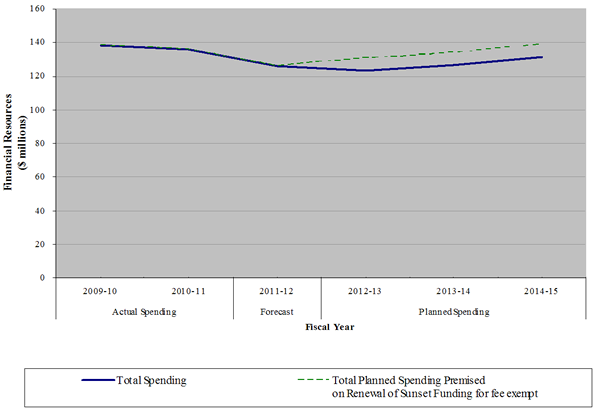
In 2009, the CNSC conducted a strategic review, as requested by central agencies, of the funding, relevance and performance of its entire program spending to ensure results and value for money. The CNSC identified program budget reductions for the Canadian Safeguards Support Program, international travel, and specific outreach activities. The strategic review has led to a decrease in funding over a three-year period of $0.8 million in fiscal year 2010–11, $1.5 million in fiscal year 2011–12 and $2.3 million permanently effective fiscal year 2012–13.
Budget 2006 and Budget 2008 earmarked funding for the CNSC over a period of five and three years respectively to meet regulatory workload pressures from growth in fee-exempt and non-cost-recoverable regulatory activities. These funds and related FTEs were sunsetted at the end of fiscal year 2010–11. Through the Budget 2011 process, $5.7 million of permanent funding for non-cost-recoverable activities was provided, in addition to a one-year renewal of $6.7 million for activities associated with fee-exempt licensees in fiscal year 2011–12. Currently, the CNSC is working with the Government to ensure it continues to be resourced to fulfill its mandate.
The government also initiated the administrative services review (ASR) to pool existing resources from across government to consolidate and transfer IT infrastructure (e.g., data centres and network services). The ASR has led to a permanent appropriation transfer of $1.5 million and 10 FTEs to Shared Services Canada in 2012–13.
The increase to the projected agency spending from 2012–13 to 2014–15 is a result of anticipated cost increases to be recovered from licensees through the revenue spending authority.
Estimates by vote
For information on the CNSC’s organizational appropriations, please see the 2012–13 Main Estimates.
Section II: Analysis of Program Activities by Strategic Outcome
Strategic outcome
The CNSC has a single strategic outcome: safe and secure nuclear installations and processes used solely for peaceful purposes and public confidence in the nuclear regulatory regime’s effectiveness. To support this outcome, the CNSC has four program activities: Regulatory Framework, Licensing and Certification, Compliance, and Internal Services.
The following section describes the CNSC’s program activities and identifies the expected results, performance indicators and targets for each of them. It also presents the financial and human resources that will be dedicated to each activity, and explains planning highlights.
Program Activity: Regulatory Framework
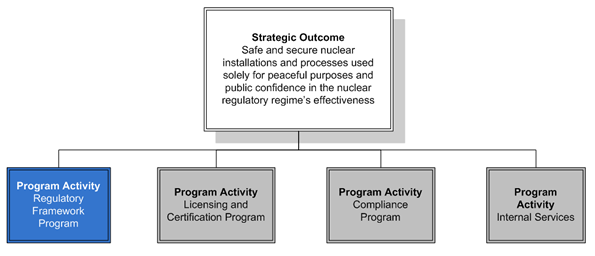
| 2012-13 | 2013-14 | 2014-15 |
|---|---|---|
| 28,041 | 28,719 | 29,847 |
| 2012-13 | 2013-14 | 2014-15 |
|---|---|---|
| 173 | 173 | 173 |
| Program Activity Expected Results | Performance Indicators | Targets |
|---|---|---|
| A clear and pragmatic regulatory framework. | Number of legal challenges to the regulatory framework. | Zero challenges, or high success rate of defending challenges. |
Program activity description
The Regulatory Framework program is in place to ensure that Canada has a clear and pragmatic regulatory framework for the nuclear industry in Canada.
Funds are used to develop and make improvements to elements of the regulatory framework (such as the Nuclear Safety Control Actand regulations under the Act; regulatory documents, such as policies, standards and guides; the Safeguards Agreement and Additional Protocol between Canada and the International Atomic Energy Agency; and Canada’s bilateral nuclear cooperation agreements) that protect the health, safety, security and environment for Canadians, while implementing Canada’s international commitments on the non-proliferation of nuclear weapons and the peaceful use of nuclear energy.
The CNSC also designates installations under the Nuclear Liability Act and, as a responsible authority under the Canadian Environmental Assessment Act, carries out environmental assessments for nuclear projects in accordance with this legislation.
The following table aligns the Regulatory Framework planning highlights with their corresponding organizational priorities, and presents the planned timeline for completion.
| Planning Highlights | Timeline for Completion |
|---|---|
| Negotiate new and amended bilateral nuclear cooperation agreements and administrative arrangements: | |
|
March 2013 |
| Consult on a policy on fitness for duty (drug and alcohol testing ) at major nuclear facilities. | March 2013 |
| Consult on a policy on safety culture in Canada’s nuclear industry. | March 2013 |
| Implement a renewed CNSC Research Program. | March 2013 |
| Planning Highlights | Timeline for Completion |
|---|---|
| Implement the staff action plan on the CNSC Fukushima Task Force recommendations. The action plan will focus on the following 3 categories: | |
|
Dec. 2015* |
|
Dec. 2013* |
|
Dec. 2015* |
| Respond to the Government of Canada’s Regulatory reform initiatives: | |
|
March 2013 |
|
Strengthen CNSC consultation practices related to regulatory initiatives. |
March 2013 |
| Establish implementation plans for MOUs with: | |
|
March 2013 |
|
March 2013 |
| Planning Highlights | Timeline for Completion |
|---|---|
| Continue modernization of the Regulatory Framework Plan, including: | |
|
March 2013 |
|
March 2013 |
|
March 2013 |
|
June 2012 |
|
March 2013 |
|
March 2013 |
|
March 2013 |
| Planning Highlights | Timeline for Completion |
|---|---|
| Deliver the CNSC 101 course, an information session on what and how the CNSC regulates, to communities across Canada. | Ongoing |
* Under the three categories there are specific actions to address the 13 Task Force Recommendations. These dates represent the final actions to close a category. For further details please see the full CNSC Staff Action Plan on the CNSC Fukushima Task Force Recommendations.
Program Activity: Licensing and Certification
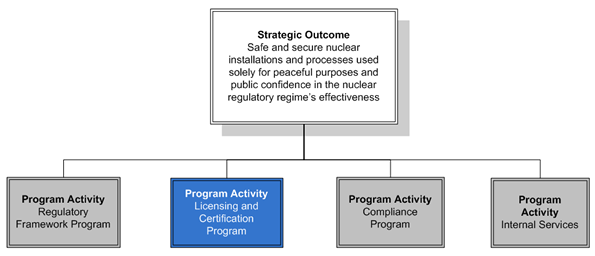
| 2012-13 | 2013-14 | 2014-15 |
|---|---|---|
| 20,150 | 20,692 | 21,477 |
| 2012-13 | 2013-14 | 2014-15 |
|---|---|---|
| 143 | 143 | 143 |
| Program Activity Expected Results | Performance Indicators | Targets |
|---|---|---|
| Licences and certificates issued as per regulatory requirements. | Application completeness notifications and licensing decisions are issued within time lines defined by external performance standards. | Per external performance standards. For complete details please see the External Performance Standards table in “Section IV: Other Items of Interest”. |
Program activity description
The Licensing and Certification program is in place to issue licences or certify persons, and prescribed equipment for conducting nuclear-related activities in Canada.
With this program activity’s funding, the CNSC obtains evidence of an applicant’s ability to operate safely and comply with all regulatory requirements.
The CNSC undertakes this work to obtain assurance that nuclear activities and facilities in Canada are managed with adequate provision for protection of the health, safety and security of Canadians and the environment, and the fulfillment of international commitments to the peaceful use of nuclear energy.
The following table aligns the Licensing and Certification planning highlights with their corresponding organizational priorities, and presents the planned timeline for completion.
| Planning Highlights | Timeline for Completion |
|---|---|
| Conduct licence application assessments (including environmental assessments) for new major nuclear projects (power reactors, uranium mines and mills, waste management facilities): | |
|
March 2013 |
|
March 2013 |
|
March 2013 |
|
March 2013 |
| Continue regulatory oversight (licensing, certification and compliance verification) for more than 2,500 licensees of nuclear substances, prescribed equipment and Class II nuclear facilities involved in medical, industrial, commercial and academic settings. | Ongoing |
| Implement regulatory oversight (licensing, certification and compliance verification) of low-energy accelerators. | March 2014 |
| Extend requirement for financial guarantees to Class II nuclear facilities and users of nuclear substances and prescribed equipment. | March 2014 |
| Support Joint Review Panel for the Deep Geologic Repository. | March 2013 |
| Undertake regulatory reviews of applications for licence renewals, under the new licence format and licence condition handbook for: |
|
|
Dec 2012 |
|
May 2012 |
|
June 2012 |
| Undertake regulatory reviews of applications to consolidate and renew Pickering A and Pickering B power reactor operating licences (hearings). | June 2013 |
| Provide regulatory oversight of the Fuel Channel Life Management Project applicable for the continued operation at Pickering B, Darlington, Bruce A and Bruce B. | Ongoing |
| Implement the Fukushima Action Plan. | Ongoing |
| Provide regulatory oversight for refurbishment projects: | |
|
Ongoing |
|
Ongoing |
|
Ongoing |
|
March 2013 |
|
Nov. 2012 |
|
July 2013 |
| Continue regulatory oversight of the Port Hope Area Initiative. | Ongoing |
| Undertake regulatory reviews for non-reactor applications for medical isotopes. | Ongoing |
| Planning Highlights | Timeline for Completion |
|---|---|
| Implement licence reform for uranium mines and mills. | Sept 2013 |
| Continue analysis of aging on reactor operation, including fitness for service and development of a strategy for the preservation of safety margins. | Ongoing |
| Planning Highlights | Timeline for Completion |
|---|---|
| Undertake vendor design reviews: | |
|
June 2013 |
|
March 2013 |
|
January 2014 |
Program Activity: Compliance
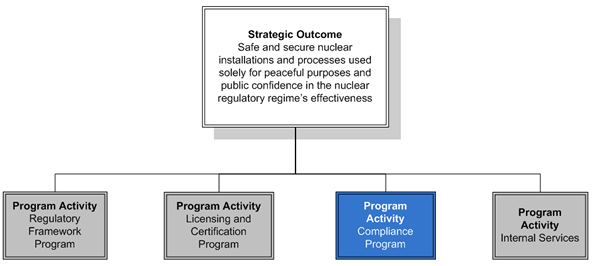
| 2012-13 | 2013-14 | 2014-15 |
|---|---|---|
| 36,412 | 37,427 | 38,828 |
| 2012-13 | 2013-14 | 2014-15 |
|---|---|---|
| 271 | 271 | 271 |
| Program Activity Expected Results | Performance Indicators | Targets |
|---|---|---|
| Licensees comply with the regulatory framework. | Compliance activity reports issued to licensees within timelines defined by external performance standards. | Per external performance standards. For complete details please see the External Performance Standards table in “Section IV: Other Items of Interest”. |
Program activity description
The Compliance program is in place to ensure that CNSC licensees exhibit a high level of compliance with the CNSC’s regulatory framework. This program enables the CNSC to provide regulatory assurance to Canadians of the continuing compliance and safety performance of licensees.
This program activity’s funding is used for: ensuring licensees fully understand how to achieve compliance, promoting the development and maintenance of a sound safety culture and common safety values, verifying compliance through inspections and other assessments of licensee performance, and taking enforcement actions on observed non-compliance.
The following table aligns the Compliance planning highlights with their corresponding organizational priorities, and presents the planned timeline for completion.
| Planning Highlights | Timeline for Completion |
|---|---|
| Continue compliance verifications and enforcement activities for nuclear facilities, uranium mines and mills, and users of nuclear substances and prescribed equipment in Canada. | Ongoing |
| Planning Highlights | Timeline for Completion |
|---|---|
| Introduce electronic submission of nuclear material accountancy information. | March 2013 |
| Introduce electronic submission of annual compliance reports for Class II nuclear facilities and users of nuclear substances and prescribed equipment. | March 2013 |
| Implement an Independent Environmental Monitoring Program. | March 2013 |
| Enhanced mandatory reporting by Power Reactor Licensees through the implementation of RD-99.1, Reporting Requirements for Operating Nuclear Power Plants. | March 2013 |
| Enhanced proactive disclosure by Power Reactor Licensees, Class I nuclear facilities, Uranium Mines and Mills and certain Class II Nuclear Facilities through the implementation of RD/GD-99.3, Requirements and Guidance for Public Information and Disclosure. | Ongoing |
| Conduct verifications against Fukushima Action Plan. | Ongoing |
Program Activity: Internal Services
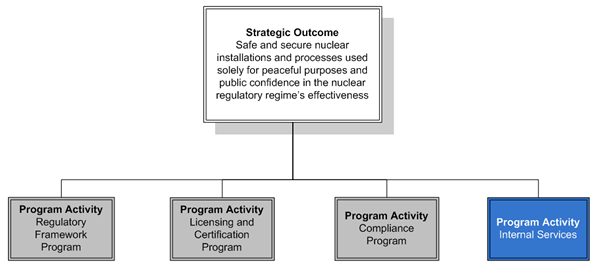
| 2012-13 | 2013-14 | 2014-15 |
|---|---|---|
| 39,226 | 40,057 | 41,692 |
| 2012-13 | 2013-14 | 2014-15 |
|---|---|---|
| 210 | 210 | 210 |
| Program Activity Expected Results | Performance Indicators | Targets |
|---|---|---|
| Activities and resources administered to support the needs of programs and other corporate obligations. |
Program activity description
Internal services are activities and resources that apply across the organization to directly and indirectly support program delivery and to meet other corporate obligations of the CNSC, as an agency of government.
These activities are: management and oversight (including audits and evaluations), communications, legal services, human resources management, financial management, information management, information technology, real property and materiel acquisition, travel and other administrative services.
The following table aligns the Internal Services planning highlights with their corresponding organizational priorities, and presents the planned timeline for completion.
| Planning Highlights | Timeline for Completion |
|---|---|
| Implement renewed CNSC engagement and corporate communications strategies. | March 2013 |
| Complete the Management Accountability Framework Assessment. | March 2013 |
| Planning Highlights | Timeline for Completion |
|---|---|
| Focus on management excellence by strengthening information to support decision making for: | |
|
Ongoing |
|
Ongoing |
|
Ongoing |
| Implement responses to the performance management framework audit and evaluation. | March 2013 |
| Planning Highlights | Timeline for Completion |
|---|---|
| Focus Human Resources activities on retention and training, specifically: | |
|
Ongoing |
|
Ongoing |
| Focus Information Management and Technology capacity on delivering priorities identified in the three-year Information Management and Technology strategic plan, specifically the development of e-services solutions. | Ongoing |
| Continue development of the financial guarantees program for non Class I licensees. | Ongoing |
| Obtain industry standard certification for the CNSC Laboratory Phase II extension to the analytical laboratory. | March 2013 |
| Planning Highlights | Timeline for Completion |
|---|---|
| Implement the Web accessibility directive. | July 2013 |
| Improve accessibility of information about the CNSC via electronic media innovation. | Ongoing |
Section III: Supplementary Information
Future-Oriented Financial Statements
Financial highlights
The future-oriented financial highlights within this Report on Plans and Priorities are intended to serve as a general overview of the CNSC’s financial operations. These future-oriented financial highlights are prepared on an accrual basis to strengthen accountability and improve transparency and financial management.
The CNSC’s future-oriented financial statements can be accessed on its web site at nuclearsafety.gc.ca.
| % Change | Future-Oriented 2012-13 |
Future-Oriented 2011-12 |
|
|---|---|---|---|
| Total Expenses | 2% | 156,195 | 152,393 |
| Total Revenues | 3% | 111,062 | 108,329 |
| Net Cost of Operations | 2% | 45,133 | 44,064 |
| % Change | Future-Oriented 2012-13 |
Future-Oriented 2011-12 |
|
|---|---|---|---|
| Total assets | -1% | 42,181 | 42,741 |
| Total liabilities | 2% | 50,927 | 50,100 |
| Equity | 19% | (8,746) | (7,359) |
| Total | -1% | 42,181 | 42,741 |
Incremental funds of $7.2 million, and associated 43 FTEs, allocated for fee-exempt activities (including safety oversight of hospitals, cancer clinics, academic institutions, other government departments and other activities currently exempt from cost recovery) expired at the end of fiscal year 2011-12. The CNSC is working with the Government to ensure that it is resourced to fulfill its mandate.
List of Supplementary Information Tables
All electronic supplementary information tables found in the 2012–13 Reports on Plans and Priorities can be found on the Treasury Board of Canada Secretariat website.
- Details on Transfer Payment Programs;
- Greening Government Operations;
- Sources of Respendable and Non-Respendable Revenue;
- Upcoming Internal Audits and Evaluations over the next three fiscal years;
Section IV: Other items of interest
* Services Received Without Charge reflect costs applicable to CNSC activities yet paid for by other government departments and reimbursed by CNSC
1 The (T) denotes temporary.
2 For program activity descriptions, please access the Main Estimates.
3 Most costs incurred for the CNSC’s regulatory activities are recovered by the federal government from licensees under the Canadian Nuclear Safety Commission Cost Recovery Fees Regulations (2003). In 2012–13, the CNSC projects to recover approximately $112.1 million in licence fees. Of the forecasted $112.1 million to be recovered from licensees, the CNSC has authority to directly respend $90.7 million pursuant to section 29.1(1) of the Financial Administration Act. The remaining $21.4 million is held centrally for costs associated with employee benefits, accommodations, health insurance and other expenditures that are directly paid for by central service providers and reimbursed by the CNSC.
4 Incremental funds of $7.2 million, and associated 43 FTEs, allocated for fee-exempt activities (including safety oversight of hospitals, cancer clinics, academic institutions, other government departments and other activities currently exempt from cost recovery) expired at the end of fiscal year 2011–12. The CNSC is working with the government to ensure that the CNSC continues to be resourced to fulfill its mandate.